
The Bassoon is a musical instrument which belongs to the aerophone, woodwind double reed family in the tenor and bass register. Attempts were made in the middle ages to create a bass instrument of low range notes with downward range and the one which was easy to handle and easy to finger. After making many variations to the existing shawms and dulcians, the instrument Bassoon was made. It is a long pipe, doubled in half and is made from wood. Though not as famous as the Clarinet, Bassoon has still managed to retain its position in the modern day musical arena and is an easily recognizable instrument of an orchestra. The Bassoon was often played for comic effect in orchestras and solo performances, but its melancholic and mellow tone also cannot be ignored. Bassoon, when played in combination with a string and other reed instruments produces a homogenous, sonorous and mellow sound. A person who plays the instrument is called a bassoonist. Let us learn more about this instrument in detail.
During the Renaissance period in the sixteenth century, the bass instrument shawm was used as a musical instrument. Bass is the lowest part of the harmony which describes tones of the lowest range. But the size (about 3 m) made it difficult to handle and finger. A new variant out of a hollow U–shaped wood block with conical tubes called the dulcian was made which produced sweet and mellow sounds. The dulcian is known as the fore–runner to the present day Bassoon. Following several alterations, two Germans namely Almenraeder and Heckel created a latest version of Bassoon with 25–27 keys which became popular as well as one which has set international standards.
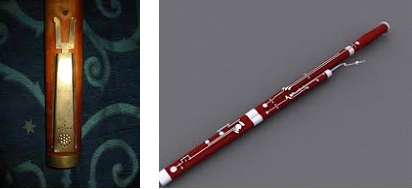
The Bassoon is held diagonally across the body with the left hand holding the top and right hand holding the bottom. The left hand covers the five finger–holes and sixteen keys on the wing and the long joint whereas the right hand covers about eleven keys on the boot. The double reed is placed between the lips and the air is blown inside which sets the two reeds vibrating. The reeds open and close very fast, sending puffs of air into the instrument which stimulates to move in sympathy. The player’s lips exert control over the reed and the left hand is responsible for seventeen different keys and nine of them are controlled by the thumb whereas the right hand controls twelve, with four controlled by the right thumb. Five holes are covered by the fingers and the rest by keys. . The key work is essential for producing the various pitches.
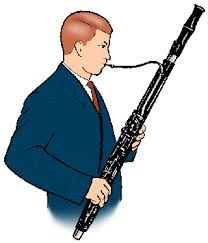
The different components of a Bassoon are a mouth–piece (double reeds, striking reed), U–shaped conical tube, bore, keys and finger–holes, bocal, bell, long joint and wing joint, boot and a strap belt.
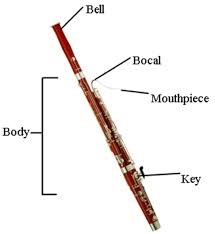
A Bassoon is generally made from wood of maple, sycamore maple, sugar maple and in the recent years, from polypropylene and ebonite. The bore of the Bassoon is conical in shape and the two bores of the boot joint are joined at the bottom of the instrument with a U–shaped metal connector. The walls of the Bassoon are thick at some points along the bore where holes are drilled at an angle to the axis of the bore. This reduces the distance between the holes so that they can be covered by the hand. Bassoons made from wood are lined with rubber to prevent damage from moisture and it is also varnished. The bocal, which connects the reed to the rest of the instrument, is inserted into a socket at the top of the wing joint. The joint between different sections consists of tenon fitting into a socket which is wrapped in cork or string to prevent air leaks. The end of the bell is fitted with a ring of metal, plastic or ivory. The height of a bassoon is about 9 feet when unfolded.
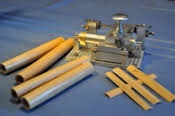
There are two types of bassoons namely the Bassoon and the Contrabassoon. The difference however, is in the size of the reeds. The Contrabassoon is comparatively larger and is known as double Bassoon because of its sheer size.
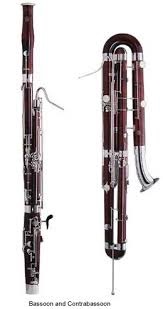
Before the nineteenth and the twentieth century, Bassoon was a part of solo, concert, opera and chamber music. In the modern times, Bassoon and the Contrabassoon are used together in orchestra along with other instruments to create mellow and low tones. Jazz, popular rock bands, sonata (with piano) classical and romantic ensemble incorporates the Bassoon and Contrabassoon.

In the earlier centuries, legendary composers Beethoven and Mozart incorporated a woodwind instrument in their ensemble. Sir Antonio Vivaldi, a well known composer wrote about 39 compositions for the Bassoons. Notable Bassoonists include Carl Almenrader, Franz Anton Pfeiffer, Dan Welcher, David Munrow, Stephen Paulson, Igor Stravinsky and Dana Jessen who are contemporary players.
The Royal Northern College of Music and Bowe Park School in UK teach various techniques of playing Bassoon. The sound of the Bassoon is lyrical and humorous. Playing this instrument involves the following steps:
- Assembling of the parts of the instrument such as the joints, tenor, bocal and the boot, etc.
- Placing of the reed in the mouth, sucking on it and then blowing in it correct positioning of the lips.
- Perfect body language.
Although the instrument is expensive, students in America are taught Bassoon performance and technique during the middle years of their music education with a school instrument provided, encouraging them to pursue lessons with private instructors. Also, they are instructed on proper posture, hand position, embouchure, tone production and reed making.


